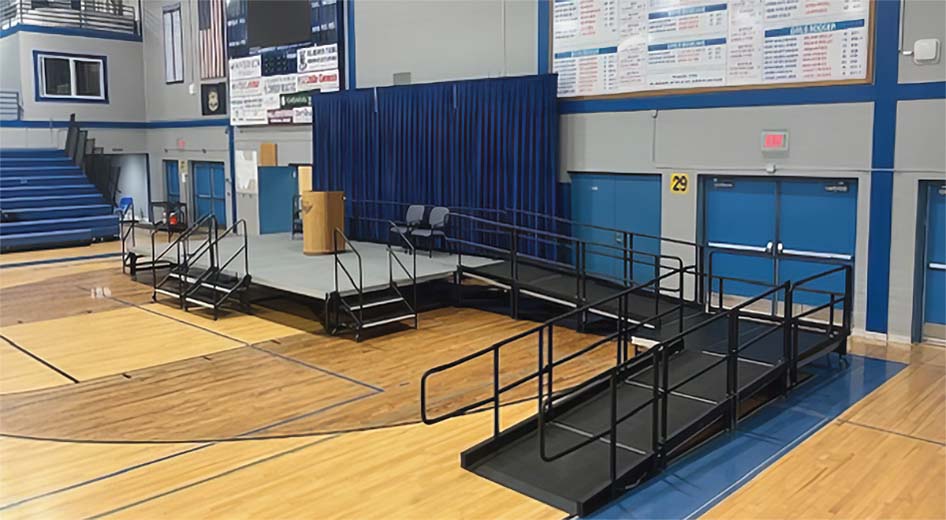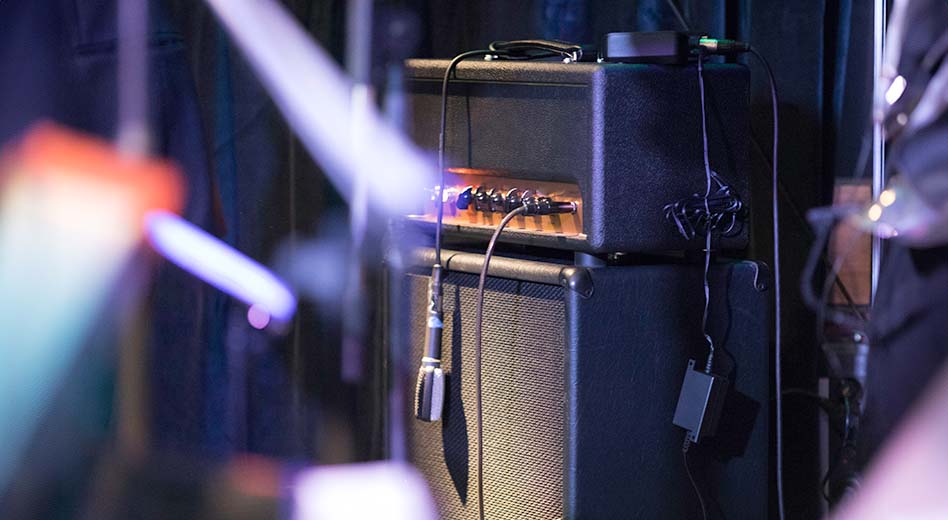
É importante escolher o tamanho, a altura e a capacidade de peso corretos para o palco portátil da sua organização. Há muito mais a se pensar do que muitos imaginam, incluindo a variedade de eventos que você pode estar hospedando, o tamanho potencial das produções ou conferências e se há requisitos exclusivos para gerenciar com segurança diferentes cargas de peso.
O artigo a seguir detalha a capacidade do palco portátil, como diferentes cargas de peso determinam o tipo de equipamento que você deve usar e como evitar erros comuns que as pessoas cometem ao escolher um palco.
O que é capacidade de palco portátil?
A capacidade do palco se refere ao peso máximo que um palco pode suportar com segurança. Vários fatores devem ser considerados ao determinar a capacidade de um palco, incluindo seu design, materiais, construção e distribuição de carga.

O que é uma classificação de carga?
Uma classificação de carga se refere à capacidade de carga de um palco, que é o peso específico uniformemente distribuído que um palco pode suportar. A capacidade de carga é medida em libras por pé quadrado (psf).
A capacidade de carga ou classificação de um estágio é determinada pelos testes do fabricante, que envolvem testes de estresse do estágio até a falha.
Diferentes tipos de classificações de carga para palcos portáteis
A segurança de um palco portátil não é estática. A capacidade de um palco portátil é determinada por vários fatores, incluindo os tipos de cargas que ele suporta.
Carga Uniforme Padrão
Este é o peso máximo que um palco pode suportar em libras por pé quadrado (psf) com peso distribuído uniformemente por toda a superfície do palco.
Carga pontual
Isso se refere ao peso máximo que um palco pode suportar em um único ponto específico sem danos. A carga pontual difere da carga uniforme padrão, pois considera onde o peso está concentrado em uma porção menor do palco.
Para planejar diferentes tipos de eventos, é importante conhecer as capacidades de carga uniforme e pontual de uma configuração de palco. Diferentes apresentações podem exigir móveis de apoio em um dia e um piano de cauda no outro. Seu palco precisa ser capaz de suportar o peso de objetos pesados em qualquer ponto.
Carga dinâmica ao vivo
Se a carga pontual for sobre ser capaz de lidar com cargas mais pesadas em locais concentrados, a carga dinâmica ao vivo mede a capacidade do seu palco portátil de suportar peso que se move. Os artistas nem sempre permanecem em um lugar no palco. Para apresentações com muita atividade física, como recitais de dança ou lutas de boxe, seu palco deve ser resistente o suficiente não apenas para suportar o peso, mas também para evitar balançar ou perder a estabilidade lateral.

Fatores a considerar ao calcular a capacidade do palco
Ao considerar as melhores opções para a configuração do seu palco portátil, você estará pesando fatores como custo, portabilidade e o tamanho e a localização dos seus eventos. Considerações sobre armazenamento também são importantes, já que palcos portáteis não serão usados em todos os eventos. Tudo isso importa e, em última análise, determinará a configuração que você precisa.
Tipo de evento e atividades
Para concertos ou apresentações de dança, você deve considerar tanto a carga pontual de qualquer equipamento pesado quanto a carga dinâmica para movimento físico. Para eventos de palestras e conferências, a carga pontual pode ser mais importante, pois seu palco precisará lidar com o peso estacionário de pódios, cadeiras e outros equipamentos. Eventos especializados, como desfiles de moda ou configurações elaboradas usando vários níveis para apresentações de bandas e corais, exigirão suporte mais robusto e distribuição cuidadosa da carga.
Número de pessoas e equipamentos
Naturalmente, o tamanho de um palco é um fator na determinação do número de pessoas que ele pode acomodar de uma vez. Não importa quão forte e robusto seja o equipamento do palco, há um limite para quantas pessoas podem sentar ou ficar de pé confortavelmente por pé quadrado. Aloque 6-10 pés quadrados por pessoa, com espaço extra ao redor da borda do palco se não houver um corrimão de segurança completo.
A resistência geral do palco também é importante ao considerar como dar suporte aos artistas no palco, já que diferentes fabricantes de palco têm diferentes capacidades de peso.
Calcule de 150 a 200 libras por pessoa ao considerar quantas pessoas podem dividir o palco ao mesmo tempo com distribuição uniforme.
Além da distribuição geral do peso, considere se esse equipamento ficará concentrado em um ponto, caso em que você precisa levar em consideração a carga pontual. Enquanto isso, considere os tipos de desempenho que você terá ao calcular a carga dinâmica.

Considere os seguintes equipamentos e seu peso:
- Equipamentos de iluminação
- Amplificadores e alto-falantes
- Equipamento de vídeo/projeção
- Adereços ou cenários
- Instrumentos musicais
Dimensões e design do palco
As dimensões do palco podem determinar que tipo de suporte estrutural é necessário para manter a carga uniforme necessária. Por exemplo, um palco menor em formato quadrado pode ter suporte suficiente para sua capacidade uniforme sem precisar de suporte extra para lidar com cargas dinâmicas e pontuais. No entanto, um palco retangular longo pode precisar de suporte extra para distribuir a capacidade de carga com segurança.
Considere se o palco precisará acomodar cenários elaborados, adereços, equipamentos de iluminação ou outros elementos de design e produção. Isso pode exigir suporte extra.
Segurança e conformidade
É importante levar em consideração a segurança e a conformidade antes de tomar qualquer decisão de compra de palco portátil. Não importa se uma organização espera usar um palco para pequenos eventos comunitários ou grandes festivais de música, aderir aos padrões de segurança é vital.
Tenha em mente as seguintes considerações de segurança e padrões regulatórios:
- Códigos de construção e normas regulatórias: Os códigos de construção locais geralmente especificam a capacidade mínima de carga e os requisitos estruturais. Os códigos de construção incluirão os padrões da Occupational Safety and Health Administration (OSHA) e do American National Standards Institute (ANSI) que você precisa cumprir. Na maioria dos casos, o peso mínimo de suporte é de 150 libras por pé quadrado (psf).
- Integridade estrutural e capacidade de carga: Após comprar um palco, inspecione os materiais do palco regularmente para detectar sinais de desgaste, conexões soltas ou outros danos potenciais. Você deve conduzir testes de carga antes de cada evento. Considere empregar monitoramento de carga em tempo real durante eventos para evitar sobrecargas acidentais.
- Segurança física: Instale guarda-corpos ou barreiras ao redor das bordas do seu palco portátil. Isso é particularmente importante para seções elevadas do palco. Para evitar quedas, use materiais antiderrapantes e instale sistemas preventivos como cintos de segurança e redes de segurança, quando necessário.
- Segurança Elétrica e Contra Incêndio: Siga os padrões de segurança elétrica, que incluem aterramento e proteção de circuito. Use capas à prova d'água para equipamentos elétricos em ambientes externos. Certifique-se de manter extintores de incêndio disponíveis.
- Acesso: Para acomodar pessoas com deficiência, certifique-se de seguir todos os requisitos de conformidade para rampas de entrada e saída. Isso também é importante para evacuação de emergência segura.

Como calcular a capacidade do palco portátil
Com os cálculos a seguir, sempre adicione uma margem de segurança para contabilizar cargas ou movimentos não previstos no palco. Adicionar 10–20% à carga calculada é uma prática padrão. Fabricantes de palcos de alta qualidade observarão a capacidade de peso do palco. Se você não vir essas informações, poderá calculá-las você mesmo.
Todos os palcos portáteis MityLite têm capacidade de peso de 125 psf (libras por pé quadrado) ou 4.000 libras por seção do palco.
Para calcular a capacidade de um palco portátil, siga estes passos.
- Determine as dimensões do palco: Calcule o comprimento, a largura e a altura do palco.
- Identifique a resistência do material: Os materiais dos quais seu palco é feito, como alumínio, aço ou madeira, determinam em grande parte a capacidade de carga do palco.
- Calcule a capacidade total de carga uniforme: Este é o peso máximo que o palco pode suportar por pé quadrado sob distribuição uniforme. Calcule isso multiplicando o psf pelo número de pés quadrados. Isso é expresso como psf x sq ft.
- Identificar cargas pontuais: Para garantir que o palco possa suportar a carga em um determinado local, considere qualquer equipamento pesado e/ou artistas que ficarão concentrados em uma área. Use a mesma fórmula para capacidade de carga uniforme, com base na metragem quadrada das áreas específicas onde esse peso está concentrado.
- Considere cargas dinâmicas: Para fatorar os requisitos de resistência para seu palco portátil, você deve considerar as forças laterais. Isso pode ser complexo para medir com precisão porque envolve tomar as dimensões da superfície do palco e a aceleração da força lateral. Para tornar isso facilmente mensurável, a carga dinâmica é normalmente tratada como 10% a 20% de carga uniforme. Esse número deve ser adicionado à classificação de carga uniforme para determinar a quantidade de peso que seu palco precisa suportar.
Em todos os casos, leve em consideração quaisquer códigos de construção locais específicos, portarias e regulamentos de segurança e deixe uma margem de segurança abaixo das classificações máximas de peso. Se você estiver planejando configurações complexas ou cargas excessivamente pesadas, consulte o fabricante do palco ou um engenheiro estrutural local.
Quais são os tamanhos e alturas típicos de um palco portátil?
Embora os palcos portáteis possam vir em muitos tamanhos modulares e normalmente possam ser fixados juntos para formar qualquer tamanho de palco. Os painéis de palco portátil MityLite variam em tamanho de 3′ x 6′ a 6′ x 8′, dependendo do modelo de palco portátil.
Alturas de palco portáteis geralmente variam de 16″ a 40″, embora as alturas de palco mais populares solicitadas sejam 24″ e 16″ para a maioria dos tipos de eventos. Alguns palcos têm conjuntos de pernas ajustáveis para que você possa definir a altura correta do palco para cada evento usando as mesmas pernas.
Como regra geral, quanto maior o evento e maior o número de convidados, mais alto o palco precisará ser (para permitir que os convidados nas fileiras mais distantes vejam). Então, um evento pequeno como um casamento pode ter uma plataforma elevada com apenas 6″-10″ de altura, enquanto uma plataforma de alto-falante padrão em uma conferência teria de 16″ a 24″ de altura. Eventos e shows maiores precisarão de um palco mais alto com 24″ a 40″ de altura.

6 erros comuns na compra de um palco portátil
As organizações frequentemente cometem erros críticos ao escolher palcos portáteis para seus eventos. Isso pode ser um erro caro se significar que eles têm que substituir completamente uma configuração inadequada ou recusar oportunidades de eventos por não atenderem aos requisitos de capacidade de um evento. Além disso, erros podem levar a problemas de segurança, problemas de funcionalidade e até mesmo multas por violações de portarias.
A seguir estão alguns erros que devem ser evitados ao escolher um equipamento de preparação portátil.
1. Subestimando a capacidade de peso
É fácil considerar apenas a carga uniforme padrão declarada de um palco e subestimar os requisitos de capacidade de peso do mundo real para eventos ao vivo. Não superestimar significa que um palco pode ser inadequado para peso de carga pontual para equipamentos de palco pesados e carga dinâmica para performances ativas. Escolha um palco com alta capacidade de peso, como MityLite VersaRoll, Z-Stage ou Fold & Roll Stage, todos com capacidade de peso de 4.000 libras por peça de piso (125 libras por pé quadrado).
2. Ignorando os requisitos de segurança
Equipamentos de proteção como guarda-corpos, superfícies antiderrapantes, reforço de estabilidade, saídas de emergência claramente marcadas e ancoragem adequada são importantes. Negligenciar a necessidade de guarda-corpos pode levar a acidentes, ferimentos e processos judiciais. Ignorar os requisitos de segurança também pode levar a falhas estruturais e penalidades por não seguir os requisitos locais.
3. Não considerar opções de materiais de superfície
Escolher a superfície correta do palco é importante para a segurança e o prazer. Por exemplo, uma superfície acarpetada pode ser útil para controlar o ruído do palco, enquanto uma superfície dura e antiderrapante é importante para a segurança dos dançarinos e o desempenho ideal. Vários palcos MityLite estão disponíveis com opções de superfície reversível, permitindo que você dobre as opções de uso e personalização do evento. Se você obtiver um palco com superfícies de deck reversíveis, poderá escolher duas superfícies de vários pisos MityLite: carpete de nível comercial, PolyTrac (uma superfície de plástico ABS dura e antiderrapante) ou TechStage (piso de fibra de vidro texturizado preto).
4. Não contabilizar vários tipos de eventos
É fácil para uma organização tomar decisões de planejamento míopes para os requisitos físicos e estruturais necessários para um palco portátil. Eventos futuros podem exigir melhor visibilidade, considerando a interação do público, recursos de segurança e flexibilidade e reforço adicionais para performances mais dinâmicas. Alguns eventos podem exigir um palco com alturas variadas (como pode ser necessário para um coral ou performance musical),
5. Julgamento incorreto da configuração e do transporte
Montar e desmontar equipamentos de palco requer uma equipe de pessoas que sejam capazes de mover ou carregar todas as peças do palco para o lugar. Alguns palcos são mais fáceis de manusear do que outros. Todos os palcos MityLite são móveis ou vêm com um carrinho. (Dica: para a configuração mais fácil de palco para 1 pessoa, escolha o MityLite Fold & Roll Stage.) Considere a logística de transporte do palco móvel por toda a sua instalação, incluindo a contabilização de espaço suficiente em portas, elevadores e corredores. É fácil ignorar esses elementos de planejamento ou subestimar os recursos que eles exigirão.
6. Negligenciar a antecipação de requisitos técnicos
Plataformas, suportes e trilhos são todos importantes para uma configuração de palco segura e resistente. Alguns eventos também exigem iluminação, sistemas de som, cortinas, telas de projetor ou outros elementos. Isso significa que os planejadores de eventos devem considerar o acesso à eletricidade quando for necessária energia de nível industrial.

Compre seu Palco Portátil Através da MityLite
Esperamos que este guia ajude você a determinar os recursos certos que você precisará em um palco portátil em sua propriedade.
A MityLite fornece uma gama completa de palcos portáteis feitos de materiais de alta qualidade com ótimas relações resistência-peso. Os palcos MityLite são resistentes, adaptáveis, personalizáveis e fáceis de transportar e montar. Seja qual for a necessidade do evento, temos o design de palco para combinar.

Se você tem perguntas, é por isso que estamos aqui! Envie-nos um e-mail para info@mityinc.com ou ligue para nós em 800-909-8034.


